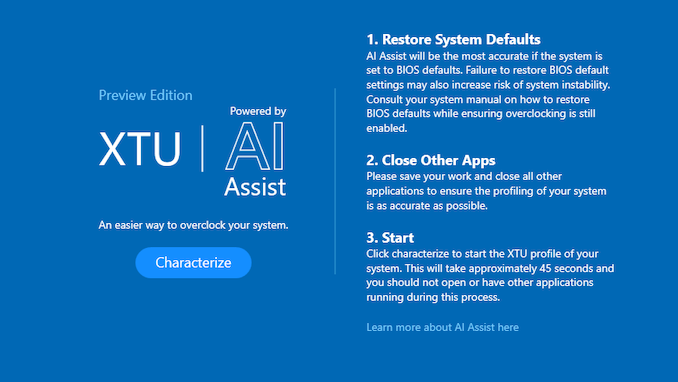Intel Core i9-14900K, Core i7-14700K and Core i5-14600K Review: Raptor Lake Refreshed
by Gavin Bonshor on October 17, 2023 9:00 AM ESTIntel AI Assist: A Better Guess At Auto Overclocking
Below, we'll give Intel's latest AI Assist feature via the Extreme Tuning Utility (XTU) software to see what it believes is the best overclock for our system and how it compares to default settings. After applying Intel's AI Assist to our Core i9-14900K, it concluded that the following settings are suitable for our test setup:
Intel's AI Assist believes our system and Core i9-14900K is capable of 6.1 GHz on the two of the P-cores and 6.0 GHz on the remaining 6 P-cores, which, based on some preliminary testing with XTU, is very ambitious, to say the least. When running a CineBench R23 MT, the system was as stable as a kite in a hurricane; not very stable at all. We did manage to get a couple of CineBench R23 MT runs in, but with thermal throttling happening instantaneously, we saw some regression in performance with a score of 39445; temperatures went straight into the red, and the system dialed back the core frequencies and CPU V-Core.
The feature is a good idea in principle, but once enabled, even though it's an Intel-marketed feature, it voids the CPU's warranty. The other element is that the additional heat and power make the applied settings under intense workloads unstable. While this is still an early feature, we would have expected more stability with the applied settings than we saw in our testing.












57 Comments
View All Comments
colinstu - Tuesday, October 17, 2023 - link
This power consumption / heat output is insane… this is putting their 90nm Netburst Prescott / Pentium D Smithfield days to shame. Remember when Apple left IBM/Motorola alliance? Power architecture power consumption going thru the roof, and intel JUST pivoted back to PIII/Pentium M-based Core arch. No wonder why Apple dumped Intel, they called what they were seeing really early on. Arm for windows/linux desktop needs to get more serious, apple's desktop arm is proving nearly as powerful using a fraction of the power draw. Windows is ready, and can even run non-arm code too.herozeros - Tuesday, October 17, 2023 - link
My AMD AM5 would like a word with you …FLEXOBENDER - Tuesday, October 17, 2023 - link
What point are you trying to make, that you have no clue how thermodynamics work?This 14900K manages to pull 430 watt peak. 430. 0.43 kilowatt. one CPU.
It is still beat by a 80 watt peak 7800x3d. What is your point?
boozed - Wednesday, October 18, 2023 - link
I think the point was that you don't have to abandon x86 for ARM to achieve good efficiency, just Intel.The Von Matrices - Thursday, October 19, 2023 - link
People remember Netburst CPUs as being absurdly power hungry, but they forget that even the most power-hungry Netburst CPUs still only had a TDP of 130W. Today that would be considered a normal or even a low TDP for a flagship CPU. It's actually understating the TDP if you compare it to a Netburst CPU.GeoffreyA - Friday, October 20, 2023 - link
And didn't Cedar Mill further drop that to a 65W TDP?GeoffreyA - Friday, October 20, 2023 - link
Possibly, ISA is just a small piece of the power puzzle, and the rest of the design is what's carrying the weight.An interesting article:
https://chipsandcheese.com/2021/07/13/arm-or-x86-i...
Azjaran - Tuesday, October 17, 2023 - link
Did i miss something or are there no temperatures shown? Because 428W shouldn't be on the low side and demands a good Cooling Solution.Gastec - Tuesday, October 17, 2023 - link
Just one question: do these AI "tools" connect to the Internet, after they "measure specific system characteristics, including telemetry from integrated sensors", to send that data to those Intel servers that are in the "cloud"?TheinsanegamerN - Tuesday, October 17, 2023 - link
Of course they do. Even if they say they dont.